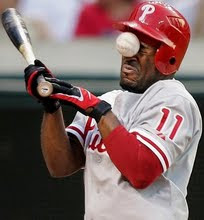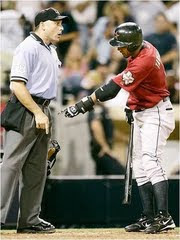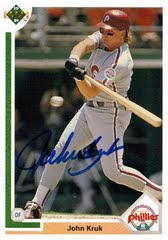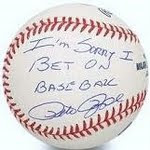All stats current through July 7.
Javier Vazquez | Marlins | SP | 25 percent Yahoo ownership
YTD: 5.64 ERA, 1.56 WHIP, 6.25 K/9, 1.82 K/BB, 32.2% GB%
Oliver ROS: 4.29 ERA, 1.33 WHIP, 7.7 K/9, 2.75 K/BB
What a fall from grace Javier Vazquez's steep and sudden decline has been. A notorious and perpetual sabermetric darling for his career, the prototype for Ricky Nolasco always put up great peripherals that never seems to match his surface stats. Some, if not most, of the gap may have been ballpark and defensive effects, however.
From 2004 to 2008, Vazquez, a flyball pitcher by trade, played in some pretty offense-inflating and home run-inflating ball parks in front of some of baseball's poorest defenses. In 2004, he played for the Yankees, who collectively posted a major league-worst team UZR total of -75.9 runs.
The 2005 season was no different, as Vazquez pitched for the third-worst defensive team in baseball, the Diamondbacks, whose -48.8 team UZR hardly offset the environmental effects of a park that used to bolster offense much more half a decade ago than it does now.
And then, of course, Vazquez famously pitched for the White Sox at US Cellular Field, one of baseball's most home run-inflating ballparks, between 2006 and 2008 before the team traded him away for Tyler Flowers and Brent Lillibridge. (Hey, at least it's more than what they got when selling Nick Swisher, who they gave up Gio Gonzalez (again) to acquire).
Though Vazquez had a solid season of results for the Sox in 2007 (15 wins, 3.74 ERA, 1.14 WHIP, 213 strikeouts over 216.2 innings pitched), his results overall were largely poor (627 innings of league-average 4.40 ERA baseball) and "unclutch" (-3.80 Clutch rating between 2006 and 2008).
Vazquez's tenure on the White Sox only saw his bad-park, bad-defense meme continue. From 2006 to 2008, perhaps largely because of Jermaine Dye (aka "Life To Flying Things"), the White Sox's -80.5 cumulative team UZR ranked fifth-worst in baseball ahead of only the Yankees, Dodgers, Diamondbacks, and Pirates.
Regardless of the results, from 2004 to 2008 Javier Vazquez's underlying peripheral performance remained strong and ranked well amongst his peers. Not only did his peripherals indicate a better-than-his-results pitcher, but Vazquez was also one of baseball's most durable.
From 2004 to 2008, Vazquez's innings pitched total of 1041.1 ranked ninth overall amongst all pitchers who played at least one game during that span. Only Johan Santana (currently on the DL), Brandon Webb (currently on the DL), Roy Oswalt (currently on the DL), Mark Buehrle, Livan Hernandez, CC Sabathia, Jon Garland (currently on the DL), and Carlos Zambrano (currently on the DL) pitched more innings during that span.
Over those 1041.1 innings, Vazquez punched out 939 batters while only walking 273, for an elite strikeout-to-walk ratio of 3.44 (2.00 MLB average). Amongst the 153 pitchers to toss 400 or more innings between 2004 and 2008, Vazquez's 21.4 percent strikeout rate (16.7 percent MLB average) and 8.12 K/9 rate both ranked 18th overall, while his 6.2 percent walk rate (7.6 percent MLB average) was the 29th lowest. His 1.26 WHIP was also 26th-best in the majors.
Despite posting the 34th-worst groundball rate (39.6 percent) amongst this sample of pitchers, Vazquez's nonetheless owned the 27th-lowest xFIP (3.85 xFIP, 87 xFIP-) of those 153 pitchers.
In 2009, then, perhaps it should come as no surprise that Vazquez was one of baseball's best pitchers. Not only did he move from the DH-laden American League to the senior circuit, a move that tends to cause a pitcher's K/9 rate to spike by +0.57, and his ERA to decrease by approximately 0.41, but for the first time in his career, Vazquez was pitching in a offense-neutral park that slightly suppressed home run production in front of a middle-of-the-league defensive team.
As might be expected, Vazquez had a career year, producing a career-best 9.77 K/9 rate, a career second-best 1.81 BB/9 rate, and a career-best xFIP and FIP (both 2.77) that were only slightly below his career-best ERA of 2.87. Vazquez rewarded fantasy owners with 15 wins and career-best 1.03 WHIP.
Among the 130 pitchers who threw 100 or more innings in 2009, no one posted a lower xFIP than Vazquez, not even Cy Young winner Tim Lincecum, whose 2.83 xFIP was the only other xFIP in baseball below 3.00 that season. Vazquez's 9.77 K/9 rate ranked sixth-best in the majors amongst all pitchers with 100 innings in 2009, his walk rate was eighth-best, and his 5.41 K/BB ratio was second only to demi-gods Roy Halladay (5.94) and Dan Haren (5.87).
Not to humble brag, but as someone who drafted Yovani Gallardo, Dan Haren, and Vazquez that season (not to mention acquiring Zack Greinke in early April), you can imagine my productive year in fantasy. Alas, I digress.
Not only was Vazquez a great pitcher in 2009, but his 219.1 innings (32 starts) that year continued his legacy of durability. That year marked his 10th consecutive season of 32 or more starts, averaging 216 innings per campaign over that span and failing to top the 200 innings mark only once with a "mere" 198 innings in 2004.
Though 34 years old entering the 2010 season, few, if any, pitchers seemed more durable with better stuffs—especially on the free agent market—and the Yankees took notice. They shipped off quality starting pitching prospect Arodys Vizcaino (and Melky Cabrera) to the Braves in order to give Vazquez a second-chance at proving New York and the AL East was not "too tough" a place for him to pitch.
Vazquez's flyball tendencies and New Yankee Stadium's first year home run-happy exhibition indicated that Vazquez was unlikely to duplicate his 2009 success for New York's Bronx Bombers in 2010, but a strikeout rate above eight batters per nine, a sub-4.00 ERA, and top-notch K/BB ratio were to nonetheless be expected. No one could have predicted what happened next, as the wheels to came off—fast. Even Andruw Jones' meteoric fall from grace took a couple of seasons to occur.
Not only did Vazquez's move from the NL back to the AL—and from Turner Field to New Yankee Stadium—cause some regression, but Vazquez completely came apart as a pitcher. His average fastball velocity, which consistently sat between 91.1 MPH and 91.8 MPH from 2005-2009, plummeted to 88.7 MPH in 2010. In only one start, in fact, did Vazquez's fastball even average 90.
Fastball velocity is highly correlated to strikeout rates, ERA, FIP, and batting averages against, so perhaps Vazquez's loss of 2.5 MPH of stink off his cheese (food metaphor!) explains his then-career-low 6.92 K/9 and career-worst FIP/xFIP marks. However, walk rates are not very affected by changes in velocity, so there must have been something else at play, perhaps a hidden injury (Vazquez ultimately did spend time on the DL in 2010) if we are to explain a career-high 3.72 BB/9.
At the least, with a 5.64 ERA and 1.40 WHIP over a near career-low 157.1 innings, the Yankees did not get what they bargained for by giving up Vizcaino. So they let him walk and wisely did not offer arbitration.
Now there were several teams out there this preseason willing to give Vazquez another chance, given his history, on various one- or two-year deals. Dave Cameron showed us that history indicated it was unlikely for Vazquez's fastball zip to return, and that perhaps we all underestimated the wear-and-tear that over 42,000 pitches and 2,647.1 innings had taken on Vazquez's arm over 13 seasons.
Nonetheless, despite all the red flags, the Marlins were willing to give Vazquez—who wanted to rebuild his stock and felt comfortably familiar with the Marlins organization—a flier on a one-year, $7 million deal that was reportedly lower in both years and money than what other teams were willing to pay.
That history brings us to this season, where Vazquez has produced a 5.64 ERA, a career-worst 1.56 WHIP, and 4.62 xFIP to date in an era where the league average pitcher has an ERA, FIP, and xFIP all in the high threes. This investment has hardly paid off thus far for the Marlins, as Vazquez's strikeout rate (6.25 K/9) has continued to decline, while his walk rate (3.43 BB/9) remains inflated.
Despite all this ugliness and recent history, however, there are several reasons for the Marlins and frugal fantasy owners to find solace in Vazquez in the second half.
First and foremost, Vazquez's velocity (2011 average to date is 89.5 MPH), which is still down below his career rate of 90.9 MPH and his 2005-2009 velocity range, is up from last year. More importantly, however, his fastball velocity has been averaging in the low 90's his past five outings. Recent fastball velocity tends to become relevant and reliable very quickly (after about three outings), so this could be a great sign for Vazquez the rest of the way.
In addition to a rekindled fastball of late, Vazquez also has rediscovered his control over his past 10 outings. Since May 9, Vazquez has tossed 54 innings and only walked 12 batters (and of those 12, only 10 were unintentional) for a walks-per-nine rate of 2.00 on the button. Meanwhile, Vazquez has punched out 46 batter (7.67 K/9) for a 3.83 K/BB rate that accords with Vazquez's 2004-2009 performance.
While walk rates take approximately a year and a half to stabilize, unintentional walk (half a season) and strikeout rates (one-fifth a season) stabilize much faster. Vazquez's full season unintentional walk rate of 2.92 this season is not too far off his career rate of 2.55, and a substantial improvement over last year's disaster rate of 3.89.
Vazquez remains an unashamed flyball pitcher this season (32.2 percent groundball percentage in 2011, 34.9 percent in past 10 years), but if we plug his past 10 starts worth of data into the latest version of the xWHIP Calculator, calibrated to the 2011 run environment, we get a good picture of the quality of his recent performance:

Noting that the eFIP and xWHIP league averages are approximately 4.00 and 1.33, respectively, it is clear that Vazquez has performed substantially more like his former self of late than his season ERA/WHIP or even past 10 starts ERA/WHIP (4.83/1.35) indicate.
Vazquez may not be one of baseball's thirty best pitchers anymore, and thus no longer an ace, but if he can continue his recent performance, a sub-4.00 ERA and strong WHIP with good strikeout totals could be in the cards. And if Hanley Ramirezcontinues to play like his former self as he has of late (past 12 games: 16-for-45, five walks, three HR, one SB, 12 RBI, nine runs), then a healthy wins total could also be coming for the disgraced starter.
Unless you are in a deep (14-plus teams) or NL-only league, chances are that Vazquez is available for free (or a $1 FAAB bid) in your league's free agency pool. While I cannot recommend starting him just yet, he is certainly worth the pickup for your bench and worthy of the type of monitoring that would require a compelling government interest.
Vazquez is likely a matchups-only play at the moment (though it is worth noting that most of his recent ten outings came against offense-heavy teams), but is equally as rosterable as, if not more so than, Rich Harden.
Keep a close eye on Vazquez after the All-Star break. He could be a second-half Josh Beckett- or Bartolo Colon-like value.
Recommendation: Javier Vazquez should be owned in NL-only leagues and at least bench-owned in 12-plus-team mixed leagues. Ten-team mixed leagues can ignore Vazquez for now, but should monitor his next five starts closely.
As always, leave the love/hate in the comments below.







0 comments:
Post a Comment